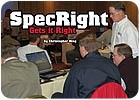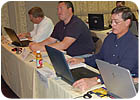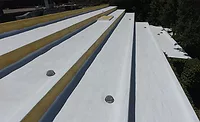SpecRight Gets it Right
When a consortium of major commercial roofing manufacturers, contractors and industry associations announced the launch of the SpecRight program at the 2006 International Roofing Expo in Las Vegas, the industry took notice.

When a consortium of major commercial roofing manufacturers, contractors and industry associations announced the launch of the SpecRight program at the 2006 International Roofing Expo in Las Vegas, the industry took notice. Bill Good, executive vice president of the National Roofing Contractors Association (NRCA), stated that the program's ultimate goal is to help roofing contractors provide useful and consistent information about roofs, energy and the environment to building owners, designers and consultants so that they can make an informed buying decision.
The first session was slated for the Chicago area in March, and Roofing Contractor was on hand for the sold-out inaugural seminar. If the initial offering is any indication, this information-packed one-day seminar and certification test are likely to become standard procedure among commercial roofing contractors.
The seminar is designed to equip contractors to educate customers about the benefits of energy-efficient roofing and culminates in a case study that allows attendees to practice using the EnergyWise Roof Calculator software, which is provided to all participants as part of the session. The case study is followed by breakout sessions that offer in-depth explorations of topics introduced in the informational session.
Bradford outlined the benefits of the program for both contractors and their customers. Contractors can differentiate themselves from the competition by acting as a consultant on energy-efficient roof design and use the EnergyWise software to illustrate how costs can be recouped through energy savings. Building owners can benefit from lower energy costs, increased property values, tax incentives and rebates, and increased lease-out rates. Both groups benefit while conserving energy and helping the environment.
He noted that the 2005 Energy Bill provides several tax deductions for commercial property, including up to $1.80 per square foot for full envelope new construction projects that exceed ASHRAE 90.1-2001 by 50 percent and up to 60 cents per square foot for partial envelope projects (such as reroofs) that exceed the standard by 50 percent.

She noted the coolness of a roof product is determined by both its reflectivity - how much of the sun's solar energy is reflected away - and its emissivity - how effectively absorbed heat is released. Cool roof theory is based on using highly reflective and highly emissive products, combined with the proper amount of insulation, to reduce the building's heat gain. These products include reflective coatings and white membranes, but Smith cautioned that not all white membranes are cool products; they must meet certain levels of reflectivity and emissivity. For example, changes to California's Title 24 enacted in October of 2005 require reflectivity rates of 0.70 and emissivity rates of 0.75. Smith noted that the Cool Roof Rating Council conducts third party testing and ratings, but does not determine performance thresholds.
John Schehl, NRCA's director of training, showed contractors how to input the roof dimensions, deck type, major penetrations, insulation levels, and utility costs for heating and cooling the building to determine the optimal options for reroofing. Schehl pointed out that the program isolates the roof system as the key variable; everything else is identical, so building owners can compare apples to apples when they consider new roof systems.
In one hypothetical example, an upgrade of $49,000 lowered the payback in energy savings from 25 years to 7.73 years - assuming energy costs stay the same.
"This is the best tool you can use to sell building owners on energy-saving upgrades," said Schehl. "With SpecRight, you're not just proving you're educated on energy efficiency, but that you can apply the principles to demonstrate the savings for the building owner."
"The software is extremely easy to use," he said. "When I got back to the office, I trained one of my staff members in how to use it, and now I hand off the data to her after a sales call, she prepares it, and we include the SpecRight package in each of our bids. We prepare the estimates using their utility bills and quote the various options, and the side-by-side comparison amazes the users.
"In one case, adding one layer of 1.5-inch insulation added $10,000 to the job, but the payback in energy savings was lowered to 2.5 years. With a 20-year life span, energy savings like that speak for themselves."
Cameron Bechtel, project manager for the Harold J. Becker Co., Dayton, Ohio, also found the seminar informative. "The EnergyWise software is very easy to figure out. I use it every week to analyze roofs I'm bidding," he said.
"New code requirements are popping up all over the country, and we believe they will become a big part of life in Ohio soon. We want to be able to help business owners realize that investing in roof upgrades can actually save them money and help the environment."
For more information about SpecRight or to register for upcoming sessions, visit www.specright.net.

Chuck Scislo (right), senior technical director for the NRCA, helps attendees get acquainted with the EnergyWise Roof Calculator software program at the inaugural SpecRight seminar. (Photos by Christopher King.)
When a consortium of major commercial roofing manufacturers, contractors and industry associations announced the launch of the SpecRight program at the 2006 International Roofing Expo in Las Vegas, the industry took notice. Bill Good, executive vice president of the National Roofing Contractors Association (NRCA), stated that the program's ultimate goal is to help roofing contractors provide useful and consistent information about roofs, energy and the environment to building owners, designers and consultants so that they can make an informed buying decision.
The first session was slated for the Chicago area in March, and Roofing Contractor was on hand for the sold-out inaugural seminar. If the initial offering is any indication, this information-packed one-day seminar and certification test are likely to become standard procedure among commercial roofing contractors.
The seminar is designed to equip contractors to educate customers about the benefits of energy-efficient roofing and culminates in a case study that allows attendees to practice using the EnergyWise Roof Calculator software, which is provided to all participants as part of the session. The case study is followed by breakout sessions that offer in-depth explorations of topics introduced in the informational session.
Benefits of the Program
Dane Bradford of Bradford Roof Management, Billings, Mont., and a past president of NRCA, opened the seminar by describing SpecRight as "a sales and marketing initiative, ultimately directed at building owners and facility managers, whose theme is ‘Save your energy. You've found the right roof.'" The program advocates energy-efficient roof system design, focusing on the American Society of Heating, Refrigerating and Air-Conditioning Engineers (ASHRAE) Standard 90.1, "Energy-Efficient Design of New Buildings Except Low-Rise Residential Buildings."Bradford outlined the benefits of the program for both contractors and their customers. Contractors can differentiate themselves from the competition by acting as a consultant on energy-efficient roof design and use the EnergyWise software to illustrate how costs can be recouped through energy savings. Building owners can benefit from lower energy costs, increased property values, tax incentives and rebates, and increased lease-out rates. Both groups benefit while conserving energy and helping the environment.
He noted that the 2005 Energy Bill provides several tax deductions for commercial property, including up to $1.80 per square foot for full envelope new construction projects that exceed ASHRAE 90.1-2001 by 50 percent and up to 60 cents per square foot for partial envelope projects (such as reroofs) that exceed the standard by 50 percent.

Putting their new EnergyWise software to work are SpecRight seminar attendees Mike Lowery of Anderson & Shah Roofing, Joliet, Il.; Cameron Bechtel of the Harold J. Becker Co., Dayton, Ohio; and Lee Portmann of Commercial Roofing Inc., Plover, Wis.
Sustainability, Cool Roofs
Next Jennifer Smith, marketing manger for Johns Manville Roofing Systems Group, addressed the issues of sustainable buildings and cool roofs. Noting that terms such as "sustainability" have been the subject of much debate, Smith pointed to the definition crafted by the NRCA as a proposed industry standard. According to the NRCA, a sustainable building is "a building that provides the specified building performance requirements while minimizing disturbance to and improving the functioning of local, regional and global ecosystems both during and after construction and specified service life."She noted the coolness of a roof product is determined by both its reflectivity - how much of the sun's solar energy is reflected away - and its emissivity - how effectively absorbed heat is released. Cool roof theory is based on using highly reflective and highly emissive products, combined with the proper amount of insulation, to reduce the building's heat gain. These products include reflective coatings and white membranes, but Smith cautioned that not all white membranes are cool products; they must meet certain levels of reflectivity and emissivity. For example, changes to California's Title 24 enacted in October of 2005 require reflectivity rates of 0.70 and emissivity rates of 0.75. Smith noted that the Cool Roof Rating Council conducts third party testing and ratings, but does not determine performance thresholds.
Testing the Software
After updates on building codes and voluntary programs with energy efficiency standards, such as the Environmental Protection Agency's Energy Star program and the LEED system implemented by the U. S. Green Building Council, the session brought everything together in the form of a case study, in which attendees used the EnergyWise Roof Calculator to construct virtual roof assemblies and evaluate their thermal efficiency and approximate energy costs.John Schehl, NRCA's director of training, showed contractors how to input the roof dimensions, deck type, major penetrations, insulation levels, and utility costs for heating and cooling the building to determine the optimal options for reroofing. Schehl pointed out that the program isolates the roof system as the key variable; everything else is identical, so building owners can compare apples to apples when they consider new roof systems.
In one hypothetical example, an upgrade of $49,000 lowered the payback in energy savings from 25 years to 7.73 years - assuming energy costs stay the same.
"This is the best tool you can use to sell building owners on energy-saving upgrades," said Schehl. "With SpecRight, you're not just proving you're educated on energy efficiency, but that you can apply the principles to demonstrate the savings for the building owner."
Contactor Feedback
Robert Allen is president of Allen Brothers Inc., Rochester Hills, Mich., which does 80 percent of its work in the commercial arena. He attended the inaugural SpecRight seminar because his company planned to launch a new division, Retrofit Roofing Inc., in 2006. He indicated his new division is off to a roaring start, in part due to SpecRight."The software is extremely easy to use," he said. "When I got back to the office, I trained one of my staff members in how to use it, and now I hand off the data to her after a sales call, she prepares it, and we include the SpecRight package in each of our bids. We prepare the estimates using their utility bills and quote the various options, and the side-by-side comparison amazes the users.
"In one case, adding one layer of 1.5-inch insulation added $10,000 to the job, but the payback in energy savings was lowered to 2.5 years. With a 20-year life span, energy savings like that speak for themselves."
Cameron Bechtel, project manager for the Harold J. Becker Co., Dayton, Ohio, also found the seminar informative. "The EnergyWise software is very easy to figure out. I use it every week to analyze roofs I'm bidding," he said.
"New code requirements are popping up all over the country, and we believe they will become a big part of life in Ohio soon. We want to be able to help business owners realize that investing in roof upgrades can actually save them money and help the environment."
For more information about SpecRight or to register for upcoming sessions, visit www.specright.net.
Looking for a reprint of this article?
From high-res PDFs to custom plaques, order your copy today!



